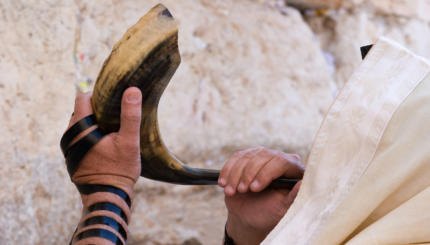I never could carry a tune but, at an early age, I discovered that I could make a soulful sound by blowing across a bottle top. Unfortunately, this set of talents did not equip me to read from the Torah or lead prayers in synagogue. While I learned to compose and deliver a dvar Torah, an active role as a spiritual leader via melody did not seem to be in the cards for me.
My capacity for making foghorn sounds with a bottle, did, however, translate into playing the flute in high school. Years later, I found that I could use the same embouchure to make sounds with a shofar. At first, I enjoyed picking up the shofar and blowing random blasts during the month of Elul. Then, when my community minyan Darkhei Noam opened auditions for female and male shofar sounders a few years ago, I decided to try out. I was given the honor of sounding the last set of kolot, blasts, after the Musaf service. I was invited to join the tradition of making a primordial sound from a ram’s horn that wakes up Jews from spiritual slumber, connects back to the Akeidah, the Sacrifice of Isaac, reminds us of the majesty and tragedy of Temple times, and evokes the sorrow of Sisera’s mother. Practicing tekiahs and shevarims took more effort than making arbitrary sounds, but yielded far more satisfaction. I learned how to think of my teruahs as three sets of triplets and prepare my breath for the tekiah gedolah. “Remember,” my coaches said, “If a Satan gets into your shofar and you can’t make a sound, just wait. Relax. You can’t force a shofar blast.”
My first year as a shofar sounder went off like a charm. The little children sat up on the stage to better see and hear the shofar. They looked at me with big, admiring eyes. I felt a special connection to the little girls on stage who seemed to sit up taller as my sounds came out strong and confident, lightly graced with a few humble quavers. My second year was a different story. A Satan found its way into my shofar. My first tekiah was more airy vibrato than anything else. And then…nothing. I forced breath into my shofar but no sound emerged. I waited. The little children pulled back their heads in surprise. Sweat beaded on my forehead and dripped down my nose. I tried again and mustered up some puny notes. After limping through the end of the blasts, I slunk to my seat and sat down, bathed in humiliation. Friends came over to comfort me, and surprisingly, to congratulate me for my effort. The next year, when for unrelated reasons I attended a different service, women from Darkhei Noam stopped me after Rosh Hashanah, telling me that they missed my shofar blowing.
This year I look forward to lifting a shofar to my lips again, at a small country community in Connecticut. I hope my sounds are strong and stir the souls of the congregation, but I know that sounding shofar is not a performance, but a prayer.
For more on the halakhot of shofar blowing, visit www.jofa.org/shofarguide
shofar
Pronounced: sho-FAR or SHO-far, Origin: Hebrew, a ram’s horn that is sounded during the month of Elul, on Rosh Hashanah, and on Yom Kippur. It is mentioned numerous times in the Bible, in reference to its ceremonial use in the Temple and to its function as a signal-horn of war.
Torah
Pronunced: TORE-uh, Origin: Hebrew, the Five Books of Moses.



